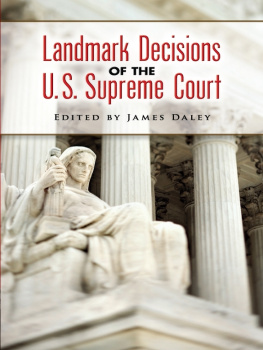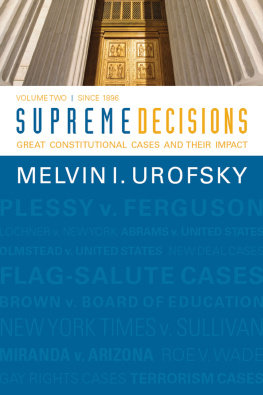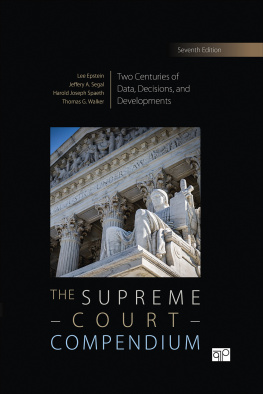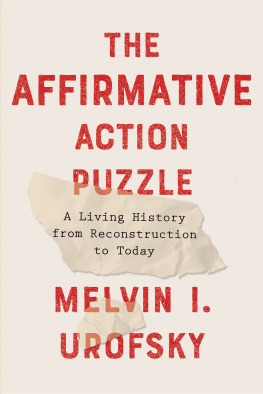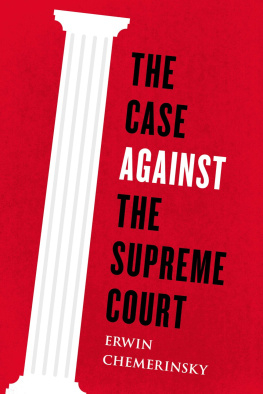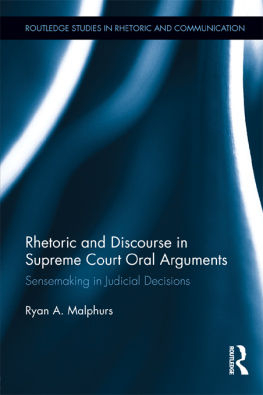Urofsky - Supreme Decisions, Combined Volume
Here you can read online Urofsky - Supreme Decisions, Combined Volume full text of the book (entire story) in english for free. Download pdf and epub, get meaning, cover and reviews about this ebook. year: 2018, publisher: Routledge, genre: Science. Description of the work, (preface) as well as reviews are available. Best literature library LitArk.com created for fans of good reading and offers a wide selection of genres:
Romance novel
Science fiction
Adventure
Detective
Science
History
Home and family
Prose
Art
Politics
Computer
Non-fiction
Religion
Business
Children
Humor
Choose a favorite category and find really read worthwhile books. Enjoy immersion in the world of imagination, feel the emotions of the characters or learn something new for yourself, make an fascinating discovery.
Supreme Decisions, Combined Volume: summary, description and annotation
We offer to read an annotation, description, summary or preface (depends on what the author of the book "Supreme Decisions, Combined Volume" wrote himself). If you haven't found the necessary information about the book — write in the comments, we will try to find it.
Urofsky: author's other books
Who wrote Supreme Decisions, Combined Volume? Find out the surname, the name of the author of the book and a list of all author's works by series.
Supreme Decisions, Combined Volume — read online for free the complete book (whole text) full work
Below is the text of the book, divided by pages. System saving the place of the last page read, allows you to conveniently read the book "Supreme Decisions, Combined Volume" online for free, without having to search again every time where you left off. Put a bookmark, and you can go to the page where you finished reading at any time.
Font size:
Interval:
Bookmark:
Volume 1:
For my children
Philip and Melissa, Robert and Leslie
And for their children
Volume 2:
For my grandchildren
Emma, Chloe, and Aaron
And for their parents
Combined Volume:
For my children, my grandchildren,
and as they requested,
for all the pooches as well

Westview Press was founded in 1975 in Boulder, Colorado, by notable publisher and intellectual Fred Praeger. Westview Press continues to publish scholarly titles and high-quality undergraduate- and graduate-level textbooks in core social science disciplines. With books developed, written, and edited with the needs of serious nonfiction readers, professors, and students in mind, Westview Press honors its long history of publishing books that matter.
Copyright 2012 by Westview Press
Published by Westview Press,
A Member of the Perseus Books Group
All rights reserved. Printed in the United States of America. No part of this book may be reproduced in any manner whatsoever without written permission except in the case of brief quotations embodied in critical articles and reviews. For information, address Westview Press, 2465 Central Avenue, Boulder, CO 80301.
Find us on the World Wide Web at www.westviewpress.com.
Every effort has been made to secure required permissions for all text, images, maps, and other art reprinted in this volume.
Westview Press books are available at special discounts for bulk purchases in the United States by corporations, institutions, and other organizations. For more information, please contact the Special Markets Department at the Perseus Books Group, 2300 Chestnut Street, Suite 200, Philadelphia, PA 19103, or call (800) 810-4145, ext. 5000, or e-mail .
A CIP catalog record of this book is available from the Library of Congress.
Supreme decisions: great constitutional cases and their impact (volume 1, volume 2, combined volume), Melvin I. Urofsky
Paperback ISBNs: Volume 1: To 1896: 978-0-8133-4731-8; Volume 2: Since 1896: 978-0-8133-4733-2; Combined Volume: 978-0-8133-4735-6 (alk. paper)
E-book ISBNs: Volume 1: To 1896: 978-0-8133-47325; Volume 2: Since 1896: 978-0-8133-4734-9; Combined Volume: 978-0-8133-4736-3
10 9 8 7 6 5 4 3 2 1
I would like to thank the reviewers whose feedback on the manuscript was so helpful, including:
Robert Allison, Suffolk University
Gordon Bakken, California State University, Fullerton
Elizabeth Dale, University of Florida
Thomas J. Davis, Arizona State University, Tempe
Sally Hadden, Western Michigan University
Eric R. Jackson, Northern Kentucky University
Patricia Minter, Western Kentucky University
Yvonne Pitts, Purdue University
Richard Polenberg, Cornell University
John C. Putman, San Diego State University
John E. Semonche, University of North Carolina [retired]
Christopher Waldrep, San Francisco State University
Laura Wittern-Keller, University of Albany
T ODAY ALL OF US RECOGNIZE that the Supreme Court plays an important part in our daily lives, as it defines what rights belong to the citizens of this country, what Congress and state legislatures can and cannot do, how far presidential authority extends, and what is the proper balance between the powers of the national government and those of the states. But when George Washington took the oath of office in 1789 as the first president under the Constitution, he had difficulty finding men to serve as justices of the Supreme Court that Congress had created. During its first decade, although the Court handed down some important decisions, few people in the country thought of the judicial arm as a coequal partner in the national government, comparable to the executive or legislative branch. The first chief justice of the United States, John Jay, resigned to become governor of New York, and Associate Justice John Rutledge left to become chief justice of South Carolina. The constitutional declaration in Article III that the judicial power of the United States shall be vested in one Supreme Court, and in such inferior courts as the Congress may from time to time ordain and establish, seemed to many an afterthought.
That, of course, changed when John Marshall became chief justice in 1801. Just as Washington had clothed the bare-bones description of the presidency with the flesh and blood of practice, so Marshall gave life to some of the key phrases of the Constitution, and in doing so made the Supreme Court not only a significant player in the affairs of the national government but also the final arbiter of what the Constitution means. For more than 210 years it has been what the Court says that has influenced major trends in our historical development, and has defined the important phrases in the Constitution. We understand what interstate commerce, freedom of speech, and equal protection of the law mean because of what the Court has said.
Each generation of Americans brings new questions before the courts, and the flexibility that the Framers built into the Constitution has allowed it to respond to issues that the founding generation never even imagined. Sometimes the decisions have been controversial, and there have been some false starts. But for the most part, the justices have done a good job of reading the words of an eighteenth-century document to cover the contingencies raised in the ensuing decades.
Although the U.S. Supreme Court is one of the most powerful constitutional courts in the world, it can only decide those issues that come within its jurisdiction. In the early nineteenth century the French traveler Alexis de Tocqueville declared that in the United States all important political questions ultimately wind up as judicial questions. But the justices cannot just reach out and decide an issue; they must wait until a case or controversy is properly brought before them, and then they carefully weigh just which questions they wish to answer.
These cases and controversies are not abstract, and they involve real peoplethe men and women who brought the issues into the courts to begin withpeople like William Marbury challenging the authority of a president, Dred Scott claiming to be free, and Myra Bradwell believing that women ought to be allowed to practice law. In more modern times we find Jacob Abrams arguing that the First Amendment gave him a right to voice unpopular opinions, Lillian Gobitas refusing to salute the flag because of her religious beliefs, and Oliver Brown wanting his daughter Linda to go to a desegregated school.
When I studied constitutional history in graduate school, and later on in law school, the emphasis was on the case holding. In this case the Court decided that a particular clause of the Constitution meant a certain thing, and therefore the statute in question was either constitutional or not. We never met the litigants, other than in one or two sentences at the beginning of the opinion setting out how the case began. One could read through such famous decisions as Marbury v. Madison (1803), Plessy v. Ferguson (1896), Olmstead v. United States (1928), and Roe v. Wade (1973) and know absolutely nothing about William Marbury, Homer Plessy, Roy Olmstead, and Norma McCorvey (Jane Roe). Who were these people? What were the circumstances that brought their cases into court? What were the larger social, economic, and political developments that lay behind their cases?
Next pageFont size:
Interval:
Bookmark:
Similar books «Supreme Decisions, Combined Volume»
Look at similar books to Supreme Decisions, Combined Volume. We have selected literature similar in name and meaning in the hope of providing readers with more options to find new, interesting, not yet read works.
Discussion, reviews of the book Supreme Decisions, Combined Volume and just readers' own opinions. Leave your comments, write what you think about the work, its meaning or the main characters. Specify what exactly you liked and what you didn't like, and why you think so.



